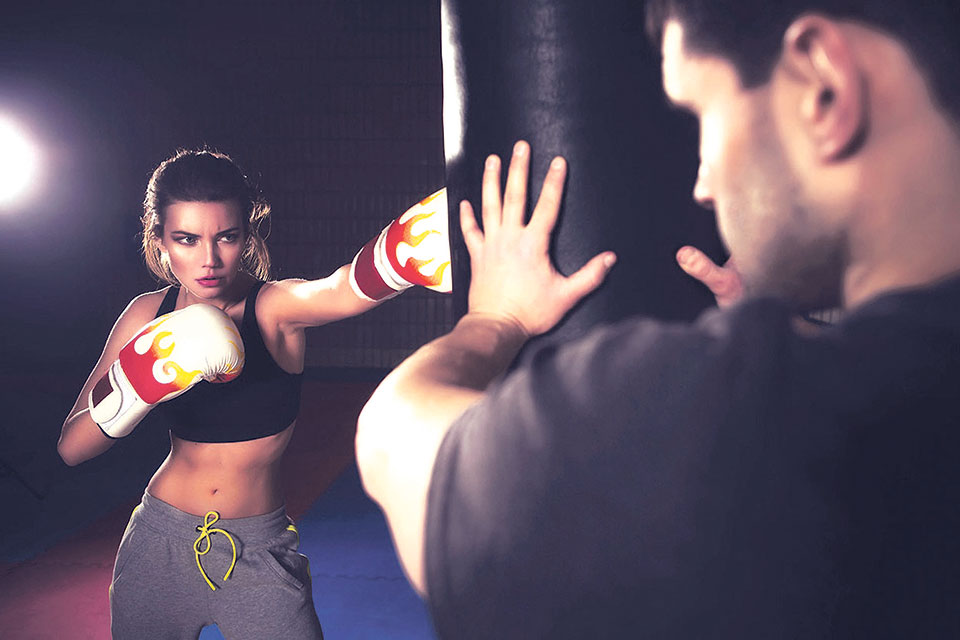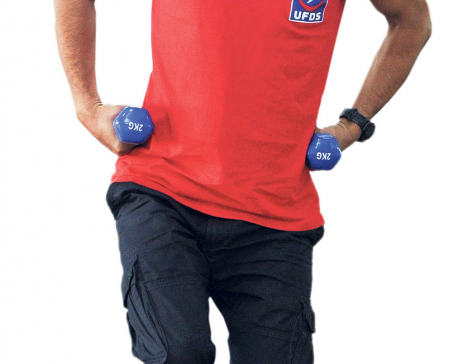
OR

Unlike weight lifting activities that focus mostly on pure strength building, kickboxing puts stress on powerful movements that requires an overall body balance. Kickboxing movements involve speed, agility, and stability. Most kickboxing enthusiasts agree with the fact that this workout increases a person’s strength, coordination, flexibility, and confidence.
 “Kickboxing has elements of martial arts and self defense strategies. That is why you not only lose weight but gain power and confidence with this exercise,” says Ajaya Joshi. To help you begin planning your kickboxing regime, The Week caught up the fitness instructor at Rage Fitness in Lalitpur. Here Joshi tells you all you need to know about this form of exercise.
“Kickboxing has elements of martial arts and self defense strategies. That is why you not only lose weight but gain power and confidence with this exercise,” says Ajaya Joshi. To help you begin planning your kickboxing regime, The Week caught up the fitness instructor at Rage Fitness in Lalitpur. Here Joshi tells you all you need to know about this form of exercise.
Determining your goal
The first step to kickboxing is setting your goal. You need to decide whether you want to improve your cardiovascular health, enhance overall conditioning, or lose weight. Once you know what you want you can consult a gym instructor and start your fitness regime. The best way to start kickboxing is by taking a few trial classes and figuring out if you are really interested in this form of workout.
Also be aware of your own body and figure out what you can handle. It is advisable to exercise under expert supervision, especially if you have chronic conditions such as diabetes, asthma. Be honest with your instructor and exercise only as much as your body allows you to. It is imperative to listen to your body while working out and not push yourself beyond its limits.
Getting geared up
There is no special clothing requirement for kickboxing. The usual gym clothing works for any kickboxing class. Any comfortable shorts or track pants will be good enough for a kickboxing workout. Gloves are usually provided at the gym. However, according to Joshi, bringing your own gloves to the gym is more hygienic. Cross-trainer shoes or aerobics shoes are much better for kickboxing than running or walking shoes.
Headgears are usually not required if your kickboxing workout only involves cardiovascular exercises. However, if you intend to get involved in fight classes along with workout, you can ask for the required headgear at the gym itself.
Exercises you can expect
Kickboxing may be different from other forms of exercises as it will require your body to perform powerful movements. Exercises in kickboxing involves short bouts that are about three minutes long. This form of workout mainly focuses on repetitive movements. It is also a workout that engages almost every muscle in your body. It mostly involves drills and demanding movements without any rest.
It is actually a combination of martial arts techniques with fast paced cardio. Upper body movements include jabs, crosses, box, hooks, pushups and uppercuts and lower body movements include high knee, back knee, back kick, knee strike, roadhouse kicks and knee strikes. These sessions involve full body workout. Unlike other gym classes, kickboxing does not have a separate day dedicated to one part of your body. The classes for kickboxing also involve warmup and cool down sessions which are extremely essential. Both dynamic and static stretching is a must for kickboxing.
Target group
Kickboxing is best suitable for people who get easily bored with stationary cardio equipments. Cardio classes are fast paced and there are new movements that can be enjoyable and tiring at the same time.
Also, everybody is welcome to join any cardio kickboxing class. You do not need any prior martial arts experience to join kickboxing. This exercise is also perfect for improving stamina and heart health and it is best for those who want to gain strength, stability, and shed some extra weight at the same time.
Proper fueling
You need to have proper snacks before and after kickboxing to keep your energy level high throughout the day. One must never take a class on an empty stomach. It is best to consume a healthy snack with complex carbohydrates and proteins an hour before any kickboxing workout. Banana, yogurt, cheese, peanut butter, fruits and grams provide you with good source of energy both before and after workout.
After kickboxing your body needs a lot of protein. For that, you can have boiled eggs, chocolate shake, chicken salad, or nutrition bars. Also ensure that you have lots of water after the workout to keep your body hydrated.
Kickboxing workout you can do at home
There are a few simple kickboxing exercises that can be done at home. You must perform each exercise for thirty seconds and take ten seconds active rest in between if you wish to.
Jab: You can first start by jabbing. It is a simple punch that involves putting your right leg forward and punching straight with your right hand. After thirty seconds you can change sides.
Cross: This involves stepping with your right leg forward and punching straight with the opposite hand. Then alternate with your left leg forward and punch with the right hand.
Hook: Put your left leg forward and punch with your hand making a circular motion. Pivot slightly towards your right every time you hook. Then perform the same exercise on the opposite side.
Uppercut: Punch upward with your fist pointing towards the ceiling. Let your left foot be forward and twist towards your left every time you punch upwards.
Front kick: In this you need to imagine as if you are slamming your legs onto a door in front of you. Perform this exercise alternately with both your legs.
You May Like This

Giroud scorpion kick shortlisted for FIFA goal award
LONDON, Oct 10: Olivier Giroud’s scorpion kick strike for Arsenal against Crystal Palace last season was shortlisted for FIFA’s goal... Read More...

Zumba toning strength and sweat session
Zumba has earned quite the popularity for being the workout class that functions more like a dance party. What’s more,... Read More...

‘Purano Dunga’ makes aggressive start at box office
KATHMANDU, Nov 27: Film ‘Purano Dunga’ of Ram Babu Gurung who had directed blockbuster ‘Kabbadi’ series has made an aggressive... Read More...



Just In
- 352 climbers obtain permits to ascend Mount Everest this season
- 16 candidates shortlisted for CEO position at Nepal Tourism Board
- WB to take financial management lead for proposed Upper Arun Project
- Power supply to be affected in parts of Kathmandu Valley today as NEA expedites repair works
- Godepani welcomes over 31,000 foreign tourists in a year
- Private sector leads hydropower generation over government
- Weather expected to be mainly fair in most parts of the country today
- 120 snow leopards found in Dolpa, survey result reveals







_20220508065243.jpg)








Leave A Comment